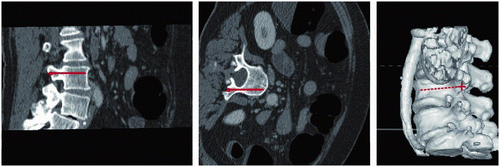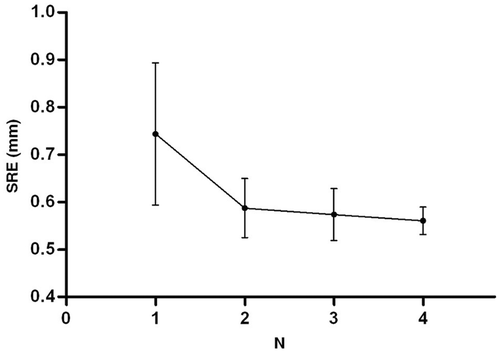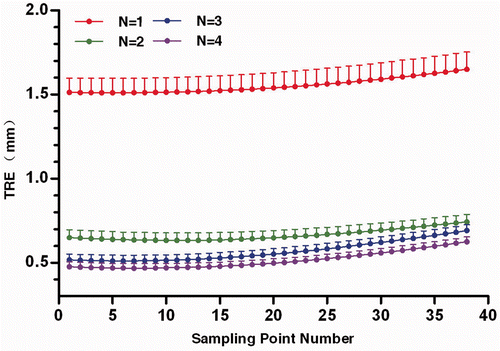Abstract
Objective: CT-based spinal navigation systems have widespread clinical applications, and spatial registration is a major source of the application error for these systems. However, the feedback that a surgeon may receive from the system, i.e., the surface registration error (SRE), is misleading, and it is still unclear how to achieve an optimal registration. The objective of this study was to investigate how the number and distribution of the points selected on the posterior surface of the vertebra influence the spatial registration accuracy, and how an optimal distribution can be achieved.
Materials and methods: We simulated the spatial registration in the image space to investigate how the number and distribution of points selected on the vertebra influenced the target registration error (TRE). First, we divided the posterior side of the vertebra into five zones and chose 30 points, evenly distributed in different combinations of zones, to simulate the points selected on the vertebra during real navigation. We registered these points to a point cloud representing the surface of the vertebra and calculated the SRE and TRE in the region of interest to determine which combination of zones was optimal. We then chose different numbers of points in the optimal zone combination to study the influence of the number of points on the registration accuracy.
Results: The combination including the lamina, both sides of the spinous process, and the four articular processes resulted in a smaller TRE than those combinations including only the lamina or the lamina with one other zone. Further enlarging the area by adding the transverse processes made no difference. In addition, the TRE decreased with the increase in the number of points, while the SRE remained almost unchanged.
Conclusion: Surgeons should select approximately 30 points distributed evenly across the lamina, both sides of the spinous process, and the four articular processes for surface matching in CT-based spinal navigation.
Introduction
Since the first report of the use of a spinal navigation system in pedicle screw placement in the lumbar spine in 1995 Citation[1], Citation[2], both the technologies and the application of spinal navigation have undergone significant evolution Citation[3], Citation[4]. The technologies used in the various types of spinal navigation system differ considerably, but all share the same basic concept: they obtain images of a patient and establish a spatial relationship between these images and the anatomy of the real patient so that the operation on the patient can be reflected on the images. The coordinate system of the images is called the image space, the coordinate system of the patient is called the patient space, and the process of calculating the spatial relationship between the two spaces is called spatial registration. During the operation, the system tracks the positions of surgical tools in the patient space and transforms them into the image space. Accordingly, virtual tools can be overlaid on the images so that the relative position of the virtual tools and the images can provide guidance as to the relative position of the real tools and the real patient.
Early spinal navigation systems used CT images for navigation, and 2D fluoroscopy-based systems were introduced approximately 10 years ago Citation[5]. The later type of spinal navigation system does not require preoperative CT imaging or manual spatial registration, while CT-based spinal navigation systems have the advantage of offering precise preoperative planning and 3D visualization of the spinal anatomy, especially with regard to the axial sections. More recent 3D fluoroscopy-based systems provide 3D navigation with volumes reconstructed from a series of 2D fluoroscopic images Citation[6],Citation[7], though the image quality is very limited. Regardless, CT-based spinal navigation systems have achieved widespread installation and application Citation[4].
For a CT-based spinal navigation system, spatial registration has to be performed manually, and the registration accuracy has a significant influence on the overall accuracy of the system. Most CT-based spinal navigation systems use point matching followed by a surface-matching approach to register the two spaces Citation[8–13]. Many factors contribute to the error of this kind of spatial registration Citation[14], with the surgeon's decision regarding the number and distribution of points to be selected in the patient space playing an important role.
In this study, we simulated the spatial registration of CT-based spinal navigation systems in the image space, which made it possible to measure the target registration error (TRE) of arbitrary points in the image space and avoid the influence of the system error from the navigation system and the human error from the operator. In addition, we employed a straightforward global optimization approach to eliminate the influence of the local convergence property of the iterative closest point (ICP) algorithm. All these factors made it possible to study how the number and distribution of the points used for surface matching influence the application accuracy in a CT-based spinal navigation system.
Materials and Methods
Simulating surface matching in the image space and calculating TRE on a sampling line
For our experiments, we used CT images of the lumbar spine of a 62-year-old female patient who underwent spinal surgery. We chose one of the vertebrae on which the surgery was performed, and which had no visible abnormalities or pathological changes. The CT images were formatted into a 3D isotropic volume with voxel size of 1 mm * 1 mm * 1 mm, and a 3 * 3 * 3 mean filter was applied. The experiments were performed on the platform of a spinal navigation system developed in our laboratory. The workstation of the system had a 3.0 GHz CPU with Hyper-Threading technology and 10 GB memory, and the software was developed with Java.
We simulated surface matching in the following three steps:
Generating a point cloud representing the surface of the vertebra in the image space. We segmented out the vertebra from the background by thresholding and used the point cloud formed by the surface voxels of the vertebra to represent the surface of the vertebra in the image space. This point cloud was denoted as PCimage.
Generating another point cloud representing the points selected in the patient space in real navigation. First, we selected some points on the posterior side of the vertebral surface in the image space. Then, we introduced a random error to each of them and transformed them by a random transformation Ttransform to form a new point cloud, which was denoted as PCpatient. Here the random error was introduced by adding a random value with uniform distribution in [−0.5, 0.5] to each coordinate of the points. We used PCpatient to represent the points selected in the patient space in real navigation. For an arbitrary point Pi in the image space, its corresponding point Pp in the patient space could be calculated by multiplying it with Ttransform.
Registering the two point clouds and calculating TRE. We registered PCimage and PCpatient by surface matching and calculated a transformation Tregistration from the patient space to the image space. Then, point Pp was registered to a point P′i in the image space, and the distance between P′i and Pi was the TRE of point Pi. Through this approach, TRE could be calculated and analyzed for all the points in the image space, and the influence of the system or the operator on measuring TRE in real spinal navigation was avoided.
In real CT-based spinal navigation, a coarse point matching is performed before surface matching, and the residual error between the image space and patient space is not very large thereafter. Therefore, both the rotation and translation parameters in Ttransform need not be very large for generating PCpatient. In our experiments, the rotation about each axis was set to a random value with uniform distribution in [−2, 2] degrees, and the translation along each axis was set to a random value with uniform distribution in [−2, 2] pixels. shows the 3D visualization of the vertebra and an example of the points used to generate PCpatient.
Figure 1. 3D visualization of the vertebra used in the experiments. The dots are examples of points selected on the surface of the vertebra that will be used to generate PCpatient. Blue dots are points visible from the current viewing direction, and black dots are those occluded by the tip of the spinous process.
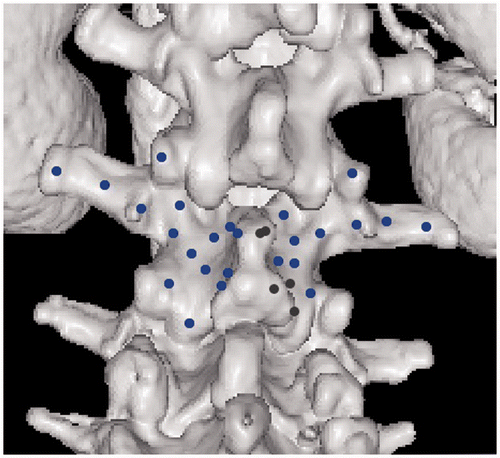
shows a sampling line, on which 38 sampling points are chosen for TRE calculation and analysis. The sampling line is approximately the trajectory of a pedicle screw through the left pedicle of the vertebra, and the sampling points are numbered from the posterior side to the anterior side. We performed three experiments that are described in detail in the following three subsections.
Influence of the local convergence property of the ICP algorithm
For this experiment we generated a PCpatient with 30 points. The points were approximately evenly distributed on the posterior sides of the lamina, the right and left sides of the spinous process, the posterior sides of the articular processes, and the transverse processes. The original position of these points is shown in . Here and in the other experiments, no points were selected on the tip of the spinous process because this is usually occluded by the reference clamp in real navigation.
Although many global optimization algorithms have been proposed to deal with the problem of local convergence of the ICP algorithm Citation[15], we adopted a very simple approach to study its influence. For each PCpatient, we performed multiple registrations with different initial positions, which were obtained by adding a small disturbance to its original position. To avoid confusion, we call this process global registration. From all the ICP registrations within a global registration, the result of the one with the smallest Surface Registration Error (SRE) was regarded as the result of the global registration. Here, SRE was the average distance between the points in PCpatient and the nearest point in PCimage after registration. The disturbance was a coordinate transformation Tsearch with three rotation parameters and three translation parameters, and all the parameters were chosen within the range of −1 to 1. The unit for rotation parameters was degrees, and the unit for translation parameters was pixels. We generated Tsearch by sampling evenly in the range, so we obtained N6 Tsearch if N samples were taken for each parameter. We called N the searching coefficient of the global registration. For example, when N = 1, PCpatient was registered to PCimage once from its original position. When N = 2, 64 Tsearch were generated, with each parameter equaling −1/3 or 1/3, and PCpatient was registered to PCimage 64 times in a global registration.
In this experiment, we generated 500 PCpatient for N = 1, 2, 3, 4, and calculated the SRE and TRE at the sampling points after global registration.
Influence of the distribution area of the points in PCpatient
We employed the area division approach used by Tamura et al. Citation[16], in which the posterior side of a vertebra was divided into five zones: (A) the tip of the spinous process; (B) the left and right sides of the spinous process; (C) the posterior side of the lamina; (D) the posterior side of the transverse processes; and (E) the posterior side of the articular processes. We selected 30 points in different combinations of zones to investigate how the spatial distribution of the points in PCpatient influenced SRE and TRE. In each combination of zones, we tried to distribute the points evenly over the whole area. We studied six PCpatient in different areas and performed 500 global registrations for each of them. The number of points falling in each zone of the six PCpatient is listed in .
Table I. Number of points falling in each zone for the six PCpatient for studying the influence of point distribution on the accuracy of surface matching.
The influence of the number of points in PCpatient
For the optimal combination of zones obtained from the previous experiment, we changed the number of points in PCpatient to study its influence on SRE and TRE. Here we selected 20, 30, 40 and 50 points and performed 500 global registrations for each of them.
Results
Influence of the local convergence property of the ICP algorithm
The statistical distribution of the SRE and the TRE for the sampling points with different searching coefficients is demonstrated in and , respectively. From , we can see that both the mean and the standard deviation (SD) of the SRE decrease with an increase in N. This is reasonable because there are more ICP registrations in one global registration with a larger N, so the global registration has more chance to choose a smaller SRE. In addition, the mean and SD of the SRE decrease dramatically when N increases from one to two, but they decrease only slightly when N increases further. Similarly, TRE for the sampling points decreases dramatically when N increases from one to two, but it only decreases by 0.1–0.2 mm when N increases from two to three or four. A TRE decrease of 0.2 mm means little for spinal navigation, especially when considering that the localization error of the tool tips is usually greater than 0.4 mm Citation[17]. However, the number of ICP registrations in one global registration increases rapidly with the increase in N, and the time needed for searching will also increase dramatically. Therefore, in the following experiments, we always used a searching coefficient of two.
Influence of the distribution area of the points in PCpatient
shows the statistical distribution of the TRE for the different PCpatient listed in . Generally speaking, TRE decreases with the increase in the number of zones in which the points of PCpatient are distributed, although the number of points in PCpatient remains unchanged. When 30 points are used in PCpatient, it is unacceptable to select all of them on the lamina. When the points are distributed on one of the other zones (PCpatient 2, 3 and 4), the TRE decreases but they are still not optimal. The TRE decreases further when two or three zones are added to the lamina to form a larger area (PCpatient 5 and 6). summarizes the statistical significance of the difference between the TRE of PCpatient 1, 2, 3, 4, 5 and the TRE of PCpatient 6 for four sampling points, 1, 13, 25 and 38, and only the difference between PCpatient 5 and 6 is statistically insignificant.
Figure 5. TRE for the sampling points with six different PCpatient as listed in . The dots represent the mean TRE, and the bars indicate the upper bound of the 95% confidence intervals.
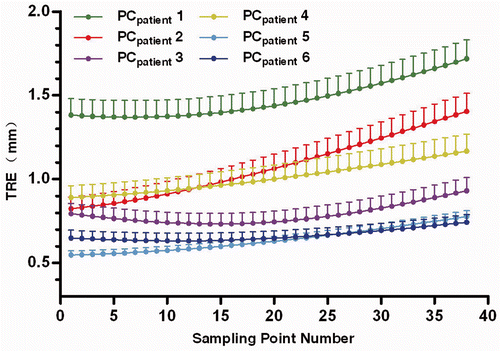
Table II. Statistical significance of the difference between the TRE for the sampling points 1, 13, 25 and 38 of PCpatient 1, 2, 3, 4, 5 and that of PCpatient 6.
Influence of the number of points in PCpatient
For the distribution area including the lamina, spinous process, and four articular processes, we generated four PCpatient containing 20, 30, 40 and 50 points, respectively. The number of points falling in the different zones of the area is shown in . In , each zone has a left and a right half, and the number of points in each half is equal. The SRE and TRE for the sampling points are shown in and , respectively. We can see that the TRE decreases with the increase in the number of points, but the SRE changes little. Most CT-based spinal navigation systems return SRE as feedback during surface matching, but from these two figures we can conclude that it is reasonable to improve registration by adding more points, though this kind of improvement cannot be reflected in the feedback of SRE. In addition, at least 30 points should be used in PCpatient.
Figure 6. SRE with different number of points in PCpatient. The dots represent the mean SRE, and the bars indicate the standard error.
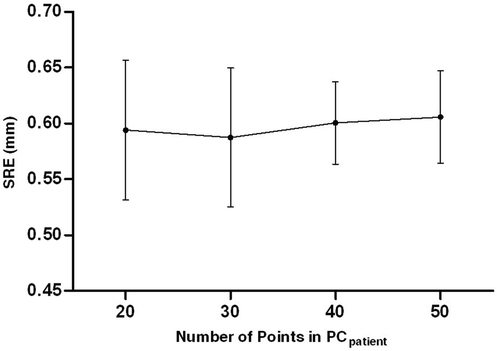
Figure 7. TRE for the sampling points with different number of points (C) in PCpatient. The dots represent the mean TRE, and the bars indicate the upper bound of the 95% confidence intervals.
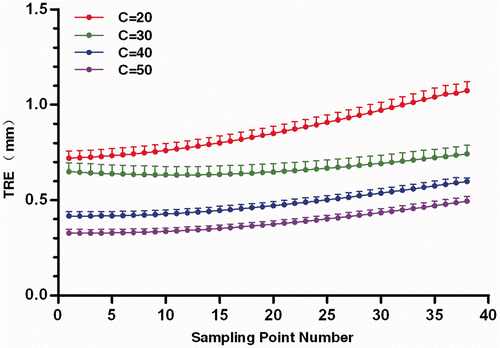
Table III. Total number of points and their distribution in different zones for studying the influence of point number on the accuracy of surface matching.
Discussion
In this study, we investigated how an optimal spatial registration can be achieved when using a CT-based spinal navigation system, and specifically how the number and distribution of the points selected on the real patient's vertebra influence the TRE. The experimental results indicate that surgeons should select 30 or more points, which are distributed approximately evenly across the lamina, both sides of the spinous process, and the four articular processes. Both a lack of points and a narrowing of the distribution area decrease the registration accuracy. It makes no difference whether several points are selected on the transverse processes, which are usually not fully accessible. In addition, registration accuracy may be improved when increasing the number of points selected on the vertebra, though this kind of improvement cannot be reflected in the feedback for SRE.
Tamura et al. studied this issue through spinal navigation performed on cadaver dry bones [16]. They attached three alumina ceramic balls to the vertebral body and used the TRE Citation[18] of the ball center as an indicator of registration accuracy. However, the TRE at different points differs, and the three ball centers are not representative of most spinal navigation. At the same time, the error measured from the navigation system might easily be biased by other factors, such as the system errors of the navigation system and the human error of the operators. In addition, the original ICP algorithm for surface matching can easily get stuck at a local minimum, which has a big influence on the results of the experiments. Ma and Ellis proposed an interactive method to determine the number and distribution of points in surface matching Citation[19]. However, their method was validated on the distal radius, proximal femur, and proximal tibia, instead of on the vertebra, and it is difficult to adjust current spinal navigation systems to implement their algorithm.
One limitation of this study is that a lumbar vertebra was used for the experiments. The results may not be valid for surface matching of cervical vertebrae since their shape is quite different. However, selecting more points across a larger area will still help to improve registration accuracy.
Conclusion
Surgeons should select approximately 30 points distributed evenly across the lamina, both sides of the spinous process, and the four articular processes for surface matching in CT-based spinal navigation. Using fewer points may result in smaller SRE, but the spatial registration is not reliable.
Declaration of interest
Prof. Song is supported by the Key Technologies R&D Program of China (Project No. 2012BAI14B05) and the Shanghai Leading Academic Discipline Project (No. B112). Dr Wang is supported by Project 81101128 supported by the NSFC and Project 11DZ2272200 and 12DZ2272200 supported by the Science and Technology Committee of Shanghai Municipality.
References
- Nolte LP, Zamorano L, Visarius H, Berlemann U, Langlotz F, Arm E, Schwarzenbach O. Clinical evaluation of a system for precision enhancement in spine surgery. Clin Biomech 1995; 10: 293–303
- Nolte LP, Visarius H, Arm E, Langlotz F, Schwarzenbach O, Zamorano L. Computer-aided fixation of spinal implants. J Image Guided Surg 1995; 1: 88–93
- Holly LT. Image-guided spinal surgery. Int J Med Robotics Comput Assist Surg 2006; 2: 7–15
- Tjardes T, Shafizadeh S, Rixen D, Paffrath T, Bouillon B, Steinhausen ES, Baethis H. Image-guided spine surgery: state of the art and future directions. Eur Spine J 2010; 19: 25–45
- Foley KT, Simon DA, Rampersaud YR. Virtual fluoroscopy: Computer-assisted fluoroscopic navigation. Spine 2001; 26: 347–351
- Wendl K, von Recum J, Wentzensen A, Grützner PA. ISO-C3D-assisted navigated implantation of pedicle screws in the thoracic and lumbar spine. Unfallchirurg 2003; 106: 907–913
- Geerling J, Gösling T, Gösling A, Ortega G, Kendoff D, Citak M, Krettek C, Hüfner T. Navigated pedicle screw placement: Experimental comparison between CT- and 3D fluoroscopy-based techniques. Comput Aided Surg 2008; 13: 157–166
- Arand M, Hartwig E, Kinzl L, Gebhard F. Spinal navigation in tumor surgery of the thoracic spine: First clinical results. Clin Orthop Relat Res 2002; 399: 211–218
- Hart RA, Hansen BL, Shea M, Hsu F, Anderson GJ. Pedicle screw placement in the thoracic spine: A comparison of image-guided and manual techniques in cadavers. Spine 2005; 30: E326–331
- Kotani Y, Abumi K, Ito M, Minami A. Improved accuracy of computer-assisted cervical pedicle screw insertion. J Neurosurg 2003; 99: 257–263
- Nottmeier EW, Crosby TL. Timing of paired points and surface matching registration in three-dimensional (3D) image-guided spinal surgery. J Spinal Disord Tech 2007; 20: 268–270
- Glossop ND, Hu RW, Randle JA. Computer-aided pedicle screw placement using frameless stereotaxis. Spine 1996; 21: 2026–2034
- Lim MR, Girardi FP, Yoon SC, Huang RC, Cammisa FP. Accuracy of computerized frameless stereotactic image-guided pedicle screw placement into previously fused lumbar spines. Spine 2005; 30: 1793–1798
- Wang MN, Song ZJ. Classification and analysis of errors in neuronavigation. Neurosurgery 2011; 68: 1131–1143
- Besl PJ, McKay ND. A method for registration of 3-D shapes. IEEE Trans Pattern Anal Mach Intell 1992; 14: 239–256
- Tamura Y, Sugano N, Sasama T, Sato Y, Tamura S, Yonenobu K, Yoshikawa H, Ochi T. Surface-based registration accuracy of CT-based image-guided spine surgery. Eur Spine J 2005; 14: 291–297
- Wiles AD, Thompson DG, Frantz DD, Accuracy assessment and interpretation for optical tracking systems. Proc SPIE 2004;5367:421–432
- Maurer CR, Jr, Fitzpatrick JM, Wang MY, Galloway RL, Jr, Maciunas RJ, Allen GS. Registration of head volume images using implantable fiducial markers. IEEE Trans Med Imaging 1997; 16: 447–462
- Ma B, Ellis RE, Unified point selection and surface-based registration using a particle filter. In: Duncan JS, Gerig G, editors. Proceedings of the 8th International Conference on Medical Image Computing and Computer-Assisted Intervention (MICCAI 2005), Palm Springs, CA, October 2005. Part I. Lecture Notes in Computer Science 3749. Berlin: Springer, 2005. pp 75–82
